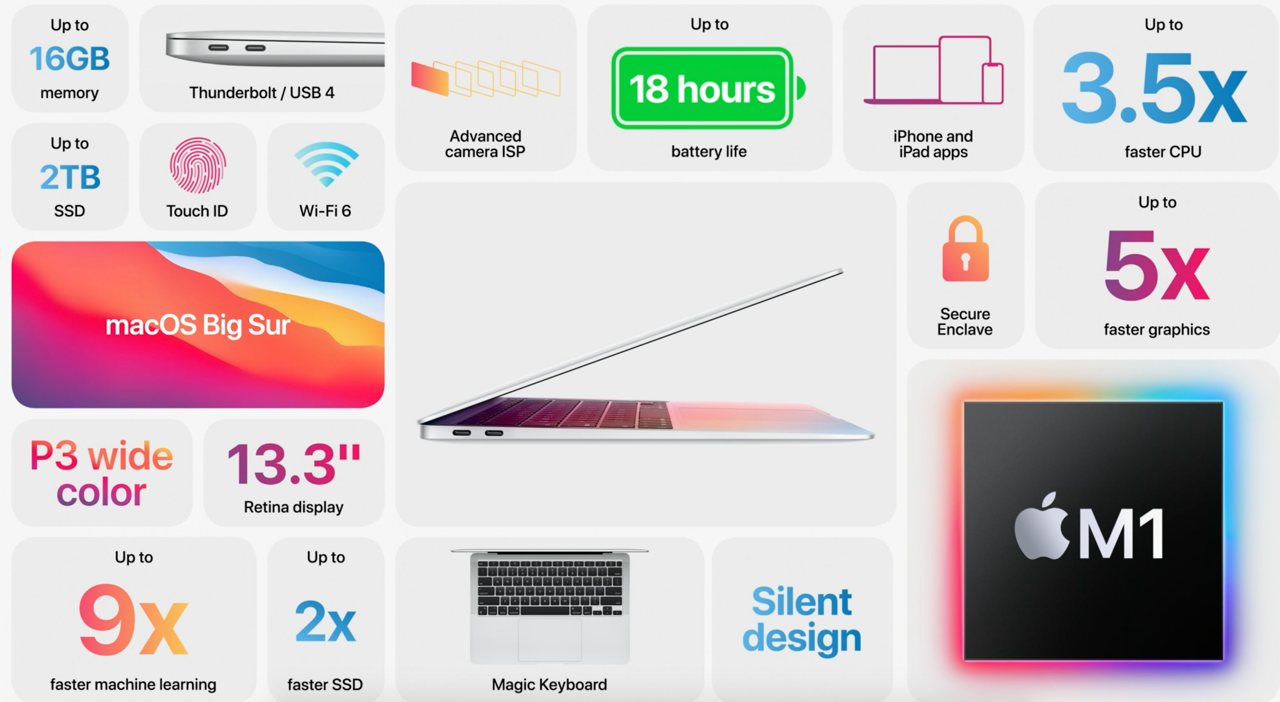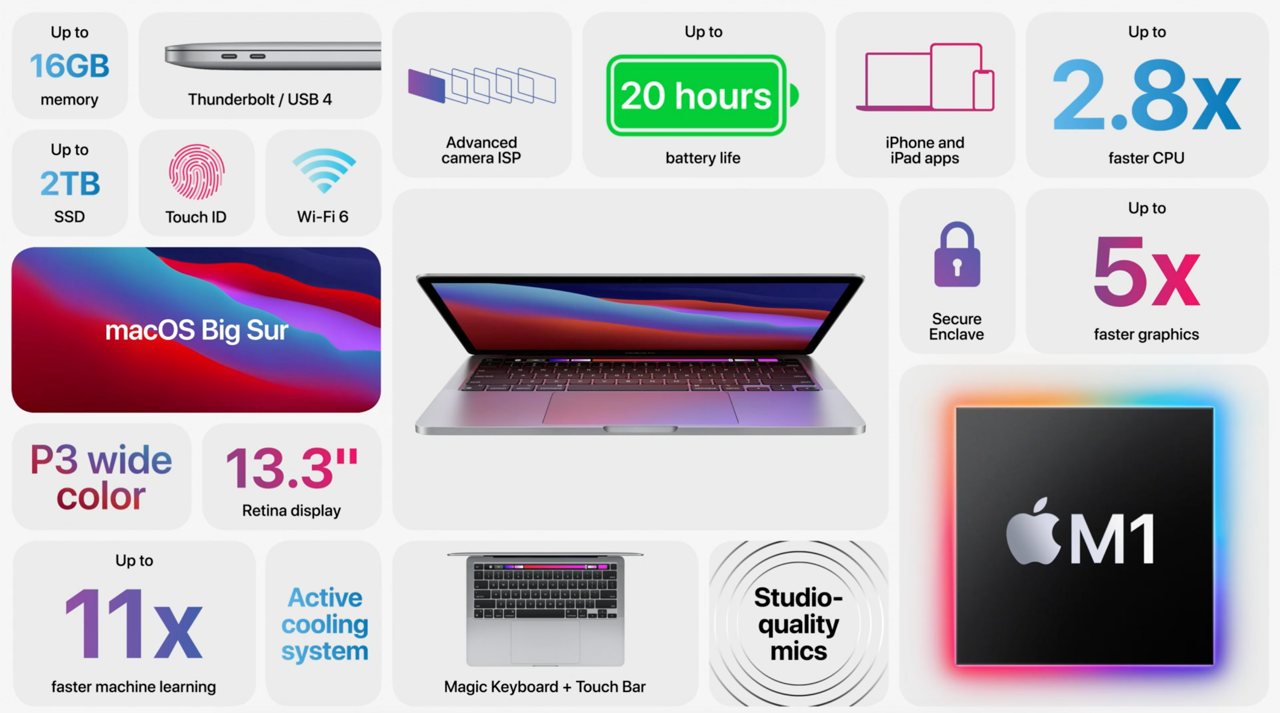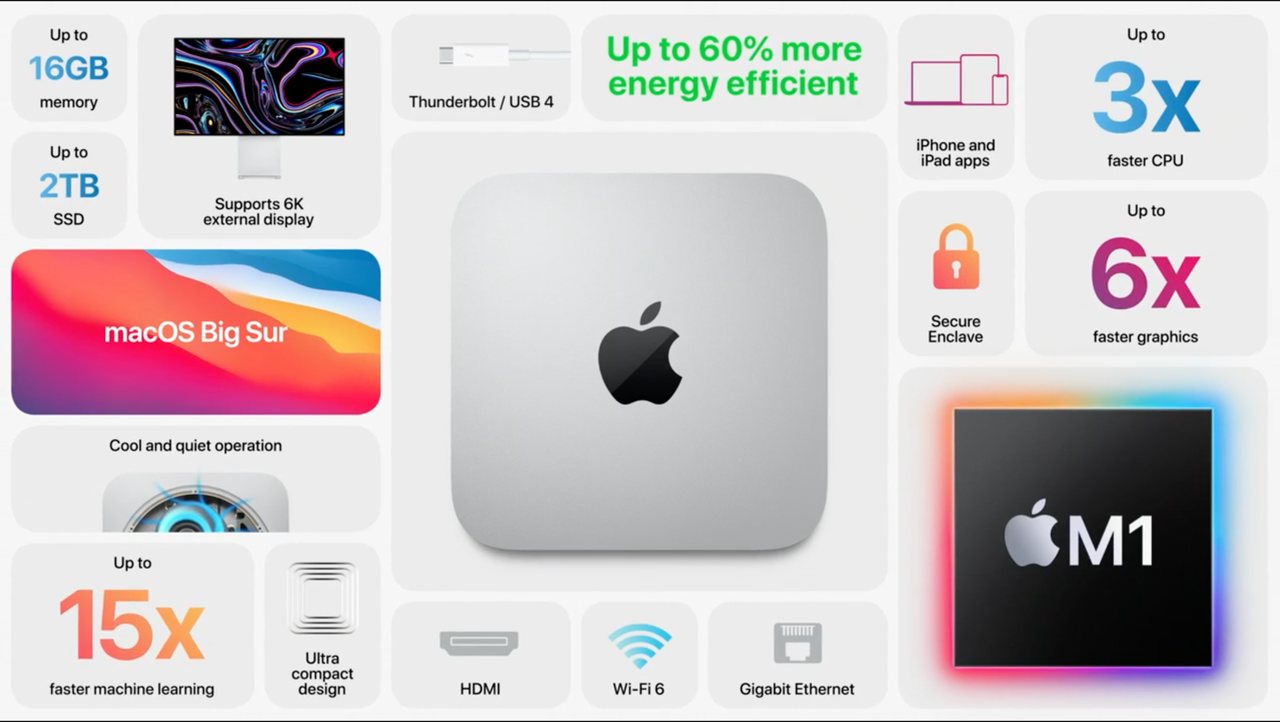Apple has finally finished its fall presentation series, which spanned three episodes this "quarantine" season. Previously, all the announcements of new iPhones were shown in September, and for the first time in many years, this tradition was broken, not least because of the unfolding pandemic, which, among other things, led to delays in the release of the new iPhone. First, on September 15, we were shown a 6th generation Apple watch , a budget version of the Apple Watch SE , an 8th generation iPad , an updated iPad Air with USB-C, and a new Fitness + subscription service . Then on October 13, Apple rolled out the new iPhone 12 , iPhone 12 mini and iPhone 12 Pro with the iPhone 12 Pro Max.... All prerequisites for today's announcement of the MacBook Air, MacBook Pro and Mac Mini were laid back in the spring, during the WWDC 2020 conference for developers , when Apple first announced plans to ditch Intel processors in its computers and switch to ARM processors codenamed Apple Silicon ... The company immediately announced that the full transition to ARM processors would take about two years. Why is this so important and why the new computers presented are so special (and what are these features for buyers?)
ARM processor Apple M1 (Apple Silicon)
As you know, ARM processors use a different architecture than Intel processors. They originated as processors for mobile systems where battery life takes precedence over performance. It is worth saying that any processor in your smartphone today is built on the ARM architecture (which makes ARM, which licenses its technologies to all manufacturers, attractive to investors - most recently NVIDIA bought it for $ 40 billion from Softbank, which, in turn, bought it in total 4 years ago for 32 billion - then we wrote about why this is important ). This applies to Qualcomm, MediaTek, Exynos or Kirin processors. In the course of its evolution (we wrote about this a year ago) ARM processors gained performance comparable to Intel processors and began to replace them . With greater energy efficiency, ARM processors allow for greater autonomy while maintaining high performance. Apple did not fail to take advantage of this, which has been developing processors for its smartphones and tablets for a long time, and now (again - it already designed PowerPC processors for its computers, until it switched to Intel processors in 2005) and computers.
What's interesting about the new Apple M1 processor? The most important thing to know about it is that it is a SoC solution.(from English System-on-a-Chip). That is, a single chip that houses the processor, DRAM, and a bunch of other components. Such solutions, for example, are used today in smart TVs. For the buyer, this means a thing that is not obvious to everyone: such a computer cannot just be upgraded by adding RAM - the entire processor will have to be changed. That is, getting greater performance (the speed of data transfer to the memory inside the chip will always be higher than to individual memory chips) and longer battery life, we will get the downside of the process: the impossibility of simply adding memory. Another highlight of the new processor is that it is based on 5-nanometer technology. Each transition to a new technology leads to lower energy consumption (same energy efficiency). It was not for nothing that Apple employees repeated as a mantra several times during the presentation that the M1 processor has the maximum performance per watt (this thesis is also on the slide below). In practice, this suggests that performance is shown in the most favorable light, but at the same time it may be lower than the most productive laptop processors of the current historical period. Separately, it is worth noting an 8-core graphics processor and a 16-core coprocessor for processing data for neural networks. We all, using the example of modern smartphones and computational photography, see a real benefit from such coprocessors working with machine learning. Apple deliberately does not use the term AI, which competitors are using with might and main. First, to stand out from the competition, second,

Apple MacBook Air with ARM-based M1 processor
What should you know about the new 2020 MacBook Air with the M1 ARM processor? Of course, this is the youngest laptop in the Apple line with the lowest performance. At the same time, Apple talks about a performance increase at times for the main processor, GPU and processor for machine learning. This all looks plausible. Battery life of up to 18 hours doesn't seem fantastic, although it's really great. It is important to know one more nuance regarding devices based on M1 processors: Rosetta 2 technology allows developers to adapt their applications for a new processor (these computers can run applications for iOS, and the Universal 2 architecture, in turn, is designed to run applications created for processors Intel with x86 architecture. Something similar was tried by Microsoft, when it offered its "universal" applications for schizophrenic Windows, which considered itself to be both a tablet and a computer, but did not succeed. In the form in which Apple made its versatility, there is much more logic - the manufacturer controls a lot more than Microsoft, which produces only the operating system and office suite. Apple does everything by itself - the processor, and the devices, and the operating system, and a large suite of applications, ranging from the iWorks suite to iMovie with Garage Band. Therefore, the developers of software and all these bundles which only releases an operating system and an office suite. Apple does everything by itself - the processor, and the devices, and the operating system, and a large suite of applications, ranging from the iWorks suite to iMovie with Garage Band. Therefore, the developers of software and all these bundles which only releases an operating system and an office suite. Apple does everything by itself - the processor, and the devices, and the operating system, and a large suite of applications, ranging from the iWorks suite to iMovie with Garage Band. Therefore, the developers of software and all these bundles Rosetta 2 / Universal 2 know perfectly well what hardware their applications will be used on. The analogy here is with PC game developers who never know the technical specifications of a user's computer and its unique set of components. And developers of games for consoles, who, on the contrary, always know what hardware the game will run on.
Separately, it is worth noting Apple's refusal to use a cooler for heat dissipation in the MacBook Air, which allows the company to talk about Silent design - a silent design. In practice, for the buyer, this will mean a silent laptop that will never have noise from the processor cooler. Everything is like in tablets and smartphones, to which we are already accustomed. It is noteworthy that the younger model (which is $ 999) is already equipped with 8 GB of RAM and a 256-gigabyte SSD, which, together with the Retina display, makes the MacBook Air a decent computer, despite the relatively low performance. Optionally, you can choose only two RAM options: 8 GB and 16 GB (remember that the memory is associated with the processor, this is SoC). But the SSD can be selected from 256 GB to 2 TB. Although putting a 2-terabyte drive in a MacBook Air looks like installing an engine from a Mercedes to a Tavria - in the maximum possible configuration with a 2 TB SSD and 16 GB of RAM, such a laptop will cost twice as much as the base price. Wi-Fi 6 support will not be superfluous - contrary to popular belief that Apple uses outdated technology, this is far from the case in laptops.

Apple MacBook Pro with ARM-based M1 processor
An important difference between the MacBook Pro and the MacBook Air in the use of active cooling (this is no longer a silent computer, although all MacBook users know that these are very quiet machines) and the claimed 20 hours of operation. The first still gives hope for greater, in comparison with the MacBook Air, performance, which in the younger model can be artificially limited. In any case, if there is no performance gain, then the rationale for buying a MacBook Pro is blurred. Indeed, you shouldn't buy it just for the sake of the Touch Bar above the keyboard, which has become a mandatory part of the MacBook Pro. Prices in the US start at $ 1,299 (excluding taxes) with the same options as the MacBook Air, meaning that in a configuration with 16GB of RAM and 2TB SSD, the price will rise by a thousand dollars. The slide also shows "studio" quality microphones, in fact, not only MacBok Pro has three microphones, but also MacBook Air - video conferencing has become an integral part of our life, so good sound will be justified. And, by the way, in both cases the scissors keyboard is used, Apple refused from butterfly keyboards because of their fragility, rightly condemned by users.

Apple Mac Mini with M1 ARM processor
As for the Mac Mini, we can say that it doesn’t need battery life, so it’s only about increasing performance. It also uses a cooler to actively cool the processor. The difference from laptops is that there is an HDMI connector and Gigabit Ethernet. Otherwise, everything is the same, with the same pricing policy - only two RAM options to choose from - 8 and 16 GB, without the possibility of upgrading it in the future. And the same set of SSDs at the same cost increments as laptops. The $ 699 low-end model looks like a good option for an entry-level home computer (not for a poor country, of course).

How much will the new MacBook Air, MacBook Pro and Mac Mini cost in Ukraine

Finally, I will reveal one little "secret". Every time after the presentation of Apple, everyone is interested in how much the new Apple products will cost in our country. In fact, the general counting scheme is so simple that you might be surprised if you are not familiar with it. To begin with, there is a practice in the United States that is not very clear to our consumer, but familiar to everyone who has ever made purchases in the United States within the country, and not on the Internet. All US prices are before taxes. Taxes vary from state to state, which also supports this strange tradition and allows companies to quote a single price for the entire country (although the actual amount may differ from state to state). That is, all these stories about $ 999 for a MacBook Air in practice do not carry any truth, and more than a kilometer of texts have already been written about this on the Internet. So let's take the $ 999 price tag, round for simplicity, up to a thousand, add 20% Ukrainian VAT and drive the phrase “1200 dollars in hryvnia” into Google. Then round up to the retail-favorite three nines. Here are those 33,999 hryvnias from the news. Similarly, we calculate the price for Mac Mini, and from 699 dollars we get 23,999 hryvnia, and for MacBook Pro - 43,999 hryvnia comes out of 1299 dollars. I hope this "pricing" will not be news or a revelation for you next time.









